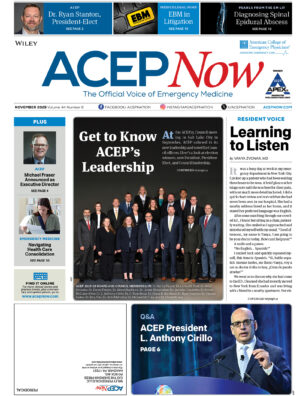
One of the most discussed and debated issues in emergency medicine over the past few years has been our workforce and how we interact with physician assistants (PAs) and advanced practice registered nurses (APRNs), including nurse practitioners (NPs). While some see advanced practice providers (APPs) as valued team members who enhance our ability to streamline patient flow and better match patient acuity to clinical resources, others raise concerns that independent practice by APPs threatens quality patient care and physician job security. Similarly, ACEP has heard concerns that some emergency physicians are required to sign charts of patients seen independently by PAs/NPs, which some feel to be both unethical and a possible medicolegal risk.
Explore This Issue
ACEP Now: Vol 38 – No 07 – July 2019For decades, ACEP has had guidelines and policies providing guidance on these issues, including policies on unsupervised care (https://bit.ly/2VTVTHt) and the role of PAs and APRNs in the emergency department (https://bit.ly/2vcYBMx). While these policies have provided valued consistency over time, many feel they need to be updated, revised, and strengthened to better reflect current industry trends and expectations for emergency care.
In response to the needs of the specialty and our membership, ACEP has formed a task force to gather data and provide guidance on the best practices for collaboration with APPs in everyday emergency medicine. This task force initially met this past October at ACEP18 and will complete its work at ACEP19 this coming October. While there have been a few papers and guidelines published by emergency physicians on this topic over the past few years, ACEP felt that the most comprehensive information and meaningful recommendations would come from a collaborative approach where all parties are able to provide their unique perspectives. As emergency medicine is rooted in team-based care, multiple stakeholder organizations were invited to actively participate in the task force. These include the American Academy of Emergency Nurse Practitioners (AAENP), American Academy of Emergency Medicine (AAEM), AAEM Resident and Student Association (RSA), American College of Osteopathic Emergency Physicians (ACOEP), Association of Academic Chairs of Emergency Medicine (AACEM), Council of Emergency Medicine Residency Directors (CORD), Emergency Medicine Residents’ Association (EMRA), Emergency Nurses Association, Society for Academic Emergency Medicine (SAEM), SAEM Residents and Medical Students (RAMS), and Society of Emergency Medicine Physician Assistants (SEMPA).
Over the past few months, we have been hard at work reviewing anything and everything related to APPs in the emergency medicine workforce, including how they are trained, what unique emergency medicine training and certifications are offered, laws about supervision and collaboration, variations in how APPs are currently supervised, current physician-to-APP ratios, billing issues and requirements related to APPs, and the regional distribution of both emergency physicians and APPs in the current workforce. Though some physicians have asked the committee to provide “preliminary guidelines” and quick updates to existing ACEP policy, due to the comprehensive nature of our review and the desire for the finished product to be thorough and comprehensive, we have elected to avoid such “quick releases” until our work is complete and we are able to provide our final recommendations.
With that said, a few interesting facts and misconceptions that have been noted relate to current APP independent practice. Despite the publicized experiences of a few, the vast majority of APPs are, in fact, directly supervised for patients with Emergency Severity Index levels 1–3. Similarly, both SEMPA and AAENP advocate for supervised and real-time collaborative practice with emergency physicians rather than independent practice. Finally, though it is not uncommon for physicians to be “required” to sign off on APP charts for patients they did not personally have direct or indirect involvement with, there is rarely any billing or legal requirement for this signature (although many states do require a degree of physician supervision for APPs). If you do find yourself in this situation and it makes you uncomfortable, take a moment to sit down with your director or administrator to discuss whether the practice is, in fact, required or simply an electronic medical record or hospital “checkbox” that could potentially be removed with no change in billing or patient care.
APPs serve an integral role in emergency care that can only be improved with better communication, guidelines, and education. As such, we look forward to being able to present the various works and recommendations of our task force with ACEP’s general membership and the medical community as a whole over the next few months. In the interim, feel free to reach out to me, your local ACEP chapter, or national ACEP with your concerns, opinions, and experiences working with APPs. The more voices that are heard and that we can represent, the stronger our work and recommendations will be.
Dr. Freess is assistant professor of emergency medicine at the University of Connecticut and clinical attending at Hartford Hospital in Hartford, Connecticut. He is Chair of the ACEP Task Force on the Utilization of PAs/NPs in Emergency Care.
Pages: 1 2 | Multi-Page



2 Responses to “ACEP Task Force Examining Collaboration with Advanced Practice Providers”
July 22, 2019
Mark BakerGreat topic and summary, thanks for working on this. I agree that communication is key. I am wondering if the Task Force will have comments on the cost of providing emergency care. The costs are likely more related to how many tests the clinician orders and not how much the clinician is paid.
mb
Hawaii
July 25, 2019
Karen WilsonIf I may, I would recommend inviting voices from critical access hospitals across the country to the task force because this is not just about supervision and quality, but about affordability as well.
Over 100 rural hospitals have closed in the last 10 years, and CAHs are turning to more affordable providers since they cannot compete with urban conveniences and wages when it comes to physicians.